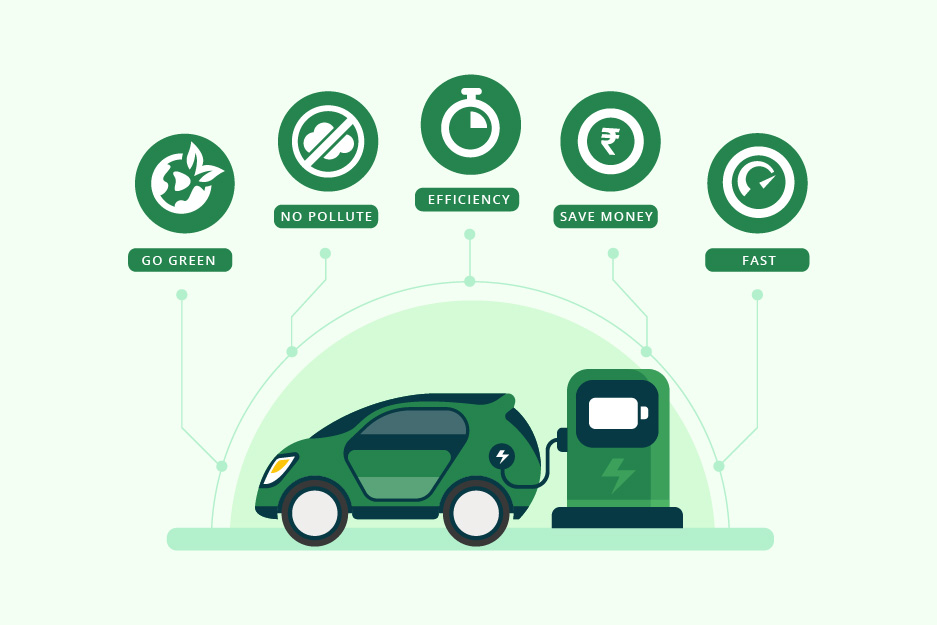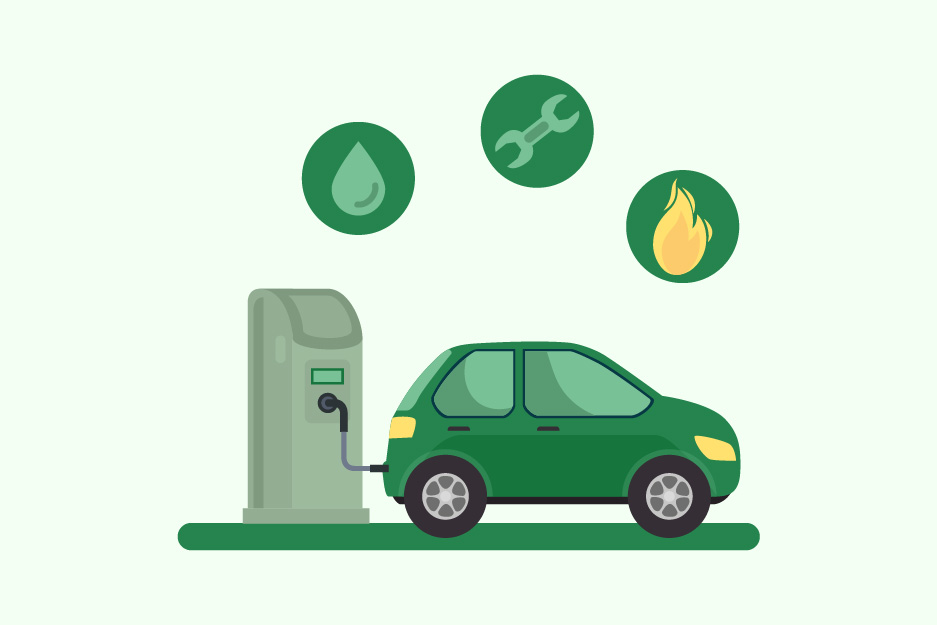Advantages and Disadvantages of Electric Vehicles (EV)
Did you know that in 2021, electric vehicles reached a new milestone of 6.6 million units sold?
Did you know that more than 16 lakh electric vehicles were sold in India between March 2023 to February 2024? This high transition towards electric vehicles is only projected to grow. As concerns about climate change and air pollution increase, people have started to seek eco-friendly alternatives over traditional fossil fuel-powered vehicles. Electric vehicles (EVs) have captured the markets due to their positive impact on the environment. This blog offers a simple guide to the advantages and disadvantages of electric vehicles in the world of transportation.
What Is An Electric Vehicle And How Does It Work?
An electric vehicle is a vehicle that uses an electric motor instead of a standard internal combustion engine (ICE). Electric vehicles work by turning the electrical energy stored in the battery into mechanical energy via the motor. This energy propels the vehicle, and when slowing down or braking, the motor can function as a generator, capturing energy through regenerative braking. The energy collected is stored in the battery for future use.
There are four major types of electric vehicles: battery electric vehicles (BEVs), plug-in hybrid electric vehicles (PHEVs), hybrid electric vehicles (HEVs), and fuel cell electric vehicles (FCEVs).


Advantages Of Electric Vehicles (EV)
As we embrace the future of EVs, it’s crucial to understand the compelling reasons that make them a smarter, cleaner, and more cost-effective choice. Let’s delve into the top advantages of electric vehicles to gain a holistic perspective on this innovative technology.
1. Low Maintenance Costs
With fewer moving parts and no need for oil changes, exhaust system repairs, or timing belt replacements, electric vehicles have more economical maintenance costs than their conventional alternatives. This translates into long-term financial savings for EV owners.
2. Lower Running Costs
Electric vehicles help individuals profit from reduced fuel expenditure since electricity is usually cheaper than fossil fuel. This can lead to substantial cost reductions and savings over the lifespan of the vehicle. Additionally, the cost of charging an EV can be further reduced by using renewable energy sources like solar power, which can be generated at home or accessed through green energy providers.
3. No Fuel, No Emissions
As electric vehicles do not rely on fossil fuels, they do not produce any emissions during operation; therefore, reducing greenhouse gas emissions and improving overall air quality.
4. Better Performance
An electric motor provides EVs with instant torque, bringing about remarkable acceleration and a smooth driving experience. Since there is no conventional transmission, acceleration, and deceleration are more refined and responsive compared to vehicles that rely on gasoline.
5. The Convenience of Charging at Home
EV owners can conveniently charge their vehicles at home, usually overnight, which eliminates the need for frequent trips to the gas station. With advancements in charging technology, EVs can be charged more quickly, or battery-swapping services can be utilized for continuous driving without traditional refueling concerns.
6. Zero Tailpipe Emissions
Electric vehicles produce no tailpipe emissions, contributing to cleaner air and reducing their carbon footprint. This is particularly important in densely populated urban areas, where air pollution is a major concern.
7. Increased Resale Value
As the demand for electric vehicles continues to grow, the resale value of EVs is expected to increase, making them a more attractive long-term investment.
8. They are Future-Proof
As charging infrastructure expands and technology advances, electric vehicles are becoming increasingly appealing and viable for a growing number of consumers. This makes them a more sustainable and environmentally friendly transportation option in the long term.
9. Tax and Financial Benefits
To promote the adoption of electric vehicles, governments offer incentives, such as tax credits, rebates, and reduced registration fees or road taxes for EV owners. These financial benefits help to offset the initial higher purchase costs associated with electric vehicles.
10. Easy to Drive and Quiet
With fewer moving parts, electric vehicles tend to be quieter and more straightforward to drive than gasoline vehicles. This creates a more enjoyable and stress-free driving experience, with less noise and vibration during operation.
11. Spacious Cabin and More Storage
Electric drivetrains’ compact design allows for increased interior space and additional storage options in electric vehicles compared to conventional vehicles. This includes under-the-hood storage, made possible by the absence of a traditional internal combustion engine.
12. Reduced Dependence on Oil
Switching to electric vehicles reduces our dependence on oil, along with the related economic, political, and environmental consequences.
13. Enhanced Safety Features
Electric vehicles often include cutting-edge safety features, such as collision prevention systems and electronic stability control, lowering accident risks.
14. Technological Advancements
Quick advancements in electric vehicle technology result in enhanced efficiency, range, and shorter charging times. These improvements make EVs increasingly competitive with traditional cars and broaden their appeal.
For a better idea of how electric vehicle works, and how to build them, you can pursue an electric vehicle course with placement.
Disadvantages Of Electric Vehicles (EV)
While electric vehicles offer numerous benefits, it’s essential to consider their drawbacks to make a well-informed decision. Let’s examine some of these disadvantages of electric vehicles to get a comprehensive understanding of the EV landscape.
1. Limited Driving Range
Although battery technology is continuously advancing, electric vehicles tend to have a shorter driving range compared to their traditional counterparts. This can cause range anxiety for some drivers, especially on long trips or in areas where charging stations are sparse.
2. Charging Infrastructure
The availability of charging stations can be limited, particularly in rural or remote regions. While the number of charging stations is steadily growing, it is yet to match the convenience and widespread availability of gas stations. Additionally, charging an EV typically takes longer than refueling a fossil fuel vehicle, which may be inconvenient for some drivers.
3. High Upfront Cost
Electric vehicles usually come with a higher purchase price, primarily due to the cost of battery technology. However, potential savings from reduced running and maintenance costs can help offset the higher initial investment over time.
4. Battery Life and Degradation
Over time, electric vehicle batteries can experience capacity degradation, which may lead to reduced driving range and performance. Battery replacements can be expensive, although it’s expected that costs will decrease as technology continues to improve and economies of scale take effect.
5. Limited Model Availability
Despite the growing number of electric vehicle models available, the selection is still somewhat limited when compared to conventional vehicles. This can make it more challenging for potential buyers to find an EV that suits their specific needs, preferences, and budget.
6. Environmental Impact of Battery Production
The production process for electric vehicle batteries can have negative environmental consequences, including habitat destruction, water pollution, and greenhouse gas emissions. However, efforts are being made to minimize these impacts through responsible sourcing of materials, recycling initiatives, and advancements in battery production technologies.
7. Lower Selling Price
Electric vehicles sell at a much lower price than their actual costs. This is due to its capacity being substantially reduced after being in operation for some time. The low selling price is seen as a disadvantage as compared to the fuel vehicles that sell at a high price.
8. Limited Users
Electric vehicles are not easily accessible to everyone due to their high cost. This limits their users, leading to low product availability. Due to the smaller user base, there may not be regular updates to the EV technology, resulting in less competitive pricing. This will increase the costs for both manufacturers and consumers.
9. Global Financial Issue
EVs are marketed as an alternative to fuel vehicles. If they continue to replace their fuel-based counterparts, it may become a challenge for the nations whose economy relies heavily on fuel sales. If the number of fuel-based vehicles declines, it may lead to a financial crisis in these countries.
10. Expensive Recharging Options
You can either recharge your EV’s battery at a charging station or at home. If you’re charging it at home with the domestic electrical power supply, your electricity bill may increase considerably. Alternatively, if you set up a charging station at home, there could be high installation charges and constant upgrades may lead to increased overall cost.
Future Of Electric Vehicles In India
According to a recent study, about 1.4 lakh electric vehicles were registered in India in February 2024. While electric two-wheelers continued to dominate the EV market, the sales of electric three-wheelers remained stable. Though electric four-wheelers and e-bus sales underperformed with small margins, the overall market continued to thrive. This highlights that the future of electric vehicles in India is bright amidst evolving market dynamics and customer preferences. The growth in the EV market is said to create a significant number of jobs by 2030.
However, there are several challenges to address, including the high cost of EVs, expensive lithium-ion batteries, safety concerns, lack of charging infrastructure, and slower performance.
To achieve the goal of having 30% of electric vehicles on the road by 2030, the government, manufacturers, and other stakeholders must work together to address these challenges and promote the adoption of EVs.


Electric Vehicle Vs Fuel Vehicle
Here is a comparison table that showcases the difference between electric vehicles and fuel vehicles:
| Parameters | Electric Vehicle | Fuel Vehicle |
| Fuel Requirement | Its operation relies on an electric motor and battery that stores and retains power. | It has a combustion engine that runs on fossil fuels like petrol and diesel. |
| Recharge | You can set up a charging station at home to recharge the vehicle. Alternatively, you can drive the vehicle to a charging spot available to the public. | You have to take the vehicle to the petrol pump for refueling. |
| Carbon Emissions | It does not emit any polluting substances and is smoke-free, making it an eco-friendly option for daily commuting. | It emits large volumes of carbon dioxide and other pollutants that are harmful to the environment. |
| Cost | It is expensive but is cost-effective in the long run due to lower charging costs than refueling. | Though it is relatively cheaper to buy, it is not cost-effective. Fuel costs fluctuate and maintenance charges are expensive. |
| Insurance | Insurance premiums are expensive for electric vehicles. | Insurance premiums are cheaper for fuel-based vehicles. |
| Registration | The government has waived off the registration charges for electric vehicles, making them an economical option. | There is a registration fee for fuel cars. It is a certain percentage of the vehicle’s cost. |
| Tax Benefits | Road taxes are comparatively lower for e-vehicles. Additionally, the government offers several incentives depending upon the state you live in. | Fuel vehicle buyers have to pay the standard road and other taxes. There are no special incentives for fuel vehicles. |
| Convenience | It is more convenient to drive as there are no complicated controls. | You need to learn the complex system of fuel cars to be able to drive them. |
| Noise Pollution | Electric motors function silently, ensuring that your vehicles do not make any noise. This contributes towards reducing noise pollution. | It comparatively contributes towards noise pollution more. |
Conclusion
Electric vehicles present a promising alternative to conventional gas-powered vehicles, with numerous benefits that can contribute to a more sustainable transportation future. Nonetheless, it’s essential to recognize and tackle potential issues and limitations as technology and infrastructure advance. By understanding the full range of the advantages and disadvantages of electric vehicles, buyers can decide if an electric vehicle suits their requirements and tastes.
FAQs
The following are the disadvantages of 100% electric vehicles:
a) EVs have less speed and shorter range than conventional vehicles.
b) It is difficult to find a charging station in locations other than major cities.
c) EVs are more expensive to buy and maintain than conventional vehicles.
d) There are few EV models to choose from since the user base is limited.
Electric cars are responsible for indirect pollution. They do not emit exhaust fumes but use batteries that emit toxic fumes. Moreover, the electricity used to power the EVs is generated from non-renewable energy sources, which is harmful for the environment.
Some of the biggest advantages of electric vehicles include the following:
a) Lower operational costs
b) Tax and financial benefits
c) Easy to drive and noiseless
d) Convenience of charging at home
Some of the advantages of hybrid electric vehicles are:
a) They supplement the fuel sources with electrical power, making them environment-friendly.
b) They are more sustainable as they consume less fuel than their counterparts.
c) They require low maintenance.
d) They offer fuel consumption efficiency by combining electric power with traditional fuel sources.
Electric vehicles have fewer operating expenses than gasoline-powered automobiles because they have fewer moving parts, require less maintenance, and electricity is usually cheaper than gasoline.
Some of the concerns about driving long distances with electric vehicles are:
a) Lack of public charging infrastructure.
b) The battery takes a considerable time to charge.
c) The low range of EVs.
Electric vehicles are usually safe. Any electric vehicle that is manufactured adhering to the design standards and regulations is considered safe for the drivers. However, the lithium-ion battery used in EVs is combustible and can catch fire. It has power cells that can cause a short circuit if it is damaged. However, these batteries have a much lower risk of fire explosions than gasoline in conventional vehicles.
Range anxiety is a common term used for apprehension experienced by EV owners about their vehicle’s battery not having enough charge to reach its destination. This is particularly prominent when people travel long distances and worry about not finding a charging station along the way.
Let’s explore why you shouldn’t be worried about the adequacy of EV batteries:
a) Charging stations are widely available.
b) The average EV range exceeds the average daily commute.
c) Fast charging is available.
The government provides tax breaks to people who purchase electric automobiles to reduce carbon emissions and dependency on fossil fuels. This is a way to encourage the use of sustainable transportation and make a positive impact on the environment.







